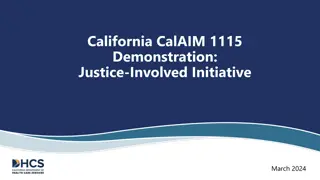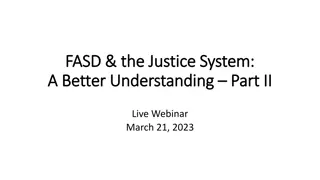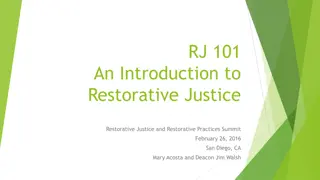Understanding FASD in the Justice System: A Comprehensive Overview
This webinar delves into the intersection of Fetal Alcohol Spectrum Disorder (FASD) and the justice system, covering topics such as diagnostic terms, the impact of an FASD diagnosis, working with FASD-affected clients, legal issues, and accommodations in court. Gain insights on how to navigate challenges and develop meaningful responses for individuals with FASD.
Download Presentation

Please find below an Image/Link to download the presentation.
The content on the website is provided AS IS for your information and personal use only. It may not be sold, licensed, or shared on other websites without obtaining consent from the author. Download presentation by click this link. If you encounter any issues during the download, it is possible that the publisher has removed the file from their server.
E N D
Presentation Transcript
FASD & the Justice System: FASD & the Justice System: A Better Understanding A Better Understanding Live Webinar October 19, 2022
What we will cover: What we will cover: 1. Overview 2. Diagnostic terms 3. Why having an FASD diagnosis makes a real difference 4. Working with a client with FASD 5. Statements made to police 6. Bail and probation conditions 7. Creative solutions work 8. Witnesses with FASD 9. Examining or cross-examining someone affected by FASD 10. Accommodations in court for accused/offender/witness with FASD 2
Overview Overview FASD is a form of brain damage arising from pre-natal alcohol There are no safe levels of PAE There are no comprehensive prevalence studies in Canada Estimate: 4% of children born every year are affected by FASD (CANFASD Network) Case law review would suggest FASD is an issue primarily for Indigenous people living west of Manitoba and in the North Cases do NOT provide a true picture of incidences of FASD nationally 3
Diagnostic Terms Diagnostic Terms Most recent Canadian FASD Diagnostic Guidelines rely on two terms FASD-sff (FASD with sentinel facial features) FASD w/o SFF (FASD without sentinel facial features These terms replace previous terms such as: FAS pFAS ARND ARBD FAE Others 4
An FASD Diagnosis Makes a Real An FASD Diagnosis Makes a Real D Difference ifference My client has FASD - Not helpful How does FASD manifest itself? What are the strengths and challenges for someone with FASD? The value of a diagnosis: it paints a more complete picture Diagnosis can provide the information that allows for a meaningful response/sentence to be developed What if there is no diagnosis and you think the person is FASD affected? 5
Working With an FASD Affected Working With an FASD Affected C Client lient How do you know if your client is FASD Affected? If you know/suspect the person is FASD Affected how does that impact the instructions you receive? Keep in mind the power imbalance Don t ask Do you have any questions for me/do you understand? Create an environment where the clients is comfortable with asking questions and not made to feel foolish or stupid 6
Statements Made to the Police Statements Made to the Police People affected by FASD are easily led to confess to things they did not do The Reid technique (and it s variations) are very problematic Don t rely on the statement from the end of the interrogation Ask to see the video and the transcripts New Zealand case Pora v the Queen [2015] UKPC 9 provides a cautionary tale 7
Bail and Probation Conditions Bail and Probation Conditions FASD affected individuals often find themselves with breach of bail and probation condition charges These breaches are treated as though the person is wilfully ignoring conditions when that may not be the case Conditions may not be fully or properly explained Ask more questions to ensure that the person understands what it means to abide by a particular condition Use of icons can be been helpful in explaining 8
Creative Solutions Work Creative Solutions Work FASD affected individuals often do not do well in group programming settings Difficulties with interpreting non-verbal and verbal cues can lead to inappropriate behaviour or sharing Don t set the person up to fail Think creatively about options that can address concerns and that are also feasible for the person Learn what the person enjoys doing and who they are comfortable working with 9
How Do You How Do You E Examine or Cross xamine or Cross- -examine A Affected by FASD ffected by FASD examine S Someone omeone Simple syntax is best Not one sentence: The witness for the crown saw two men running from the store with a stereo. Rather three sentences: The crown s witness saw two men. The two men were running from the store. They were carrying a stereo. 10
How do you examine or cross How do you examine or cross- -examine s someone omeone a affected by FASD, cont d ffected by FASD, cont d examine Not: Is the man with the scar you saw at Jimmy s house party that night the same one who came to your house the next morning? Rather: Were you at Jimmy s party that night? Did you see a man with a scar? And did the man with the scar also come to your house? And when did he come? (See Communicating Effectively With Indigenous Clients - https://www.aboriginallegal.ca/communicating-with-indigenous-clients.html) 11
Accommodations in Court for an Accommodations in Court for an Accused/Offender/ Accused/Offender/W Witness with FASD itness with FASD Accommodation for someone affected by FASD includes knowing that their attention span may be shorter so they may need more frequent breaks It may be difficult for them to sit still for long periods of time The lighting and noise in the courtroom may be distracting How do you alert the Court to these issues? 13
Ten Ways to Modify Your Approach to Be FASD- Informed: 1. 2. 3. 4. 5. 6. 7. Slow down. When offering direction or delivering instruction, do so step-by-step. Use plain and concise language. Avoid abstract language and metaphors. People with FASD are concrete thinkers. Explain things as clearly as possible. Test for understanding by asking the individual to explain in their own words their understanding of what is happening. Modify the setting if they appear to be distracted. Individuals with FASD are often visual thinkers and learners. If you are having problems communicating with words, try using pictures. Translate complex ideas or documents into understandable terms. For example, explain a bail or probation condition in plain language versus relying on template documents that can be confusing. Individuals with FASD may not understand their Charter rights or other rights if you use language that is complex for them. Explain these rights in plain language. Remember: People with FASD are often experiencing multiple challenges that are more effectively addressed outside the justice system, for example through involvement of social services or health supports. Think about this individual, how FASD manifests itself for them, and be creative. 8. 9. 10. 14
A Helpful Resource https://www.fasdjustice.ca/en-ca/























